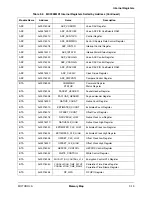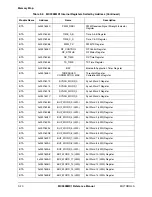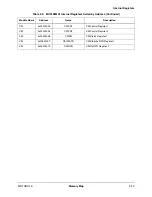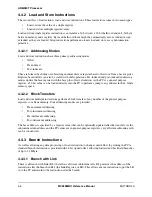
ARM920T Macrocell
MOTOROLA
ARM920T Processor
4-3
4.2.2 Cache Lock-Down
Cache lock-down is provided to allow critical code sequences to be locked into the cache to ensure
predictability for real-time code. The cache replacement algorithm can be selected by the operating system
as either pseudo random or round-robin. Both caches are 64-way set associative. Lock-down operates on a
per-set basis.
4.2.3 Write Buffer
The ARM920T processor also incorporates a 16-entry write buffer, to avoid stalling the processor when
writes to external memory are performed.
4.2.4 PATAG RAM
The ARM920T processor implements PATAG RAM to perform write-backs from the data cache. The
physical address of all the lines held in the data cache is stored by the PATAG memory, removing the need
for address translation when evicting a line from the cache.
4.2.5 MMUs
The standard ARM920T processor implements an enhanced ARM v4 memory management unit (MMU)
to provide translation and access permission checks for the instruction and data address ports of the
ARM9TDMI core.
The MMU features are:
•
Standard ARM9 v4 MMU mapping sizes, domains, and access protection scheme
•
Mapping sizes are 1 Mbyte sections, 64 kbyte large pages, 4 kbyte small pages, and new 1 kbyte
tiny pages
•
Access permissions for sections
•
Access permissions for large pages and small pages can be specified separately for each quarter of
the page (these quarters are called subpages)
•
16 domains implemented in hardware
•
64-entry instruction TLB and 64-entry data TLB
•
Hardware page table walks
•
Round-robin replacement algorithm (also called cyclic).
4.2.6 System Controller
The system controller oversees the interaction between the instruction and data caches and the Bus
Interface Unit. It controls internal arbitration between the blocks and stalls appropriate blocks when
required.
The system controller arbitrates between instruction and data access to schedule single or simultaneous
requests to the MMUs and the Bus Interface Unit. The system controller receives acknowledgement from
each resource to allow execution to continue.
The physical address of all the lines held in the data cache is stored by the PATAG memory, removing the
need for address translation when evicting a line from the cache.
Summary of Contents for DragonBall MC9328MX1
Page 68: ...1 12 MC9328MX1 Reference Manual MOTOROLA Introduction ...
Page 86: ...2 18 MC9328MX1 Reference Manual MOTOROLA Signal Descriptions and Pin Assignments ...
Page 116: ...3 30 MC9328MX1 Reference Manual MOTOROLA Memory Map ...
Page 126: ...4 10 MC9328MX1 Reference Manual MOTOROLA ARM920T Processor ...
Page 160: ...8 8 MC9328MX1 Reference Manual MOTOROLA System Control ...
Page 272: ...13 32 MC9328MX1 Reference Manual MOTOROLA DMA Controller ...
Page 281: ...Programming Model MOTOROLA Watchdog Timer Module 14 9 ...
Page 282: ...14 10 MC9328MX1 Reference Manual MOTOROLA Watchdog Timer Module ...
Page 300: ...15 18 MC9328MX1 Reference Manual MOTOROLA Analog Signal Processor ASP ...
Page 438: ...18 16 MC9328MX1 Reference Manual MOTOROLA Serial Peripheral Interface Modules SPI 1 and SPI 2 ...
Page 478: ...19 40 MC9328MX1 Reference Manual MOTOROLA LCD Controller ...
Page 574: ...21 32 MC9328MX1 Reference Manual MOTOROLA Memory Stick Host Controller MSHC Module ...
Page 598: ...23 16 MC9328MX1 Reference Manual MOTOROLA Real Time Clock RTC ...
Page 670: ...24 72 MC9328MX1 Reference Manual MOTOROLA SDRAM Memory Controller ...
Page 726: ...25 56 MC9328MX1 Reference Manual MOTOROLA SmartCard Interface Module SIM ...
Page 736: ...26 10 MC9328MX1 Reference Manual MOTOROLA General Purpose Timers ...
Page 854: ...29 18 MC9328MX1 Reference Manual MOTOROLA I2C Module ...
Page 900: ...30 46 MC9328MX1 Reference Manual MOTOROLA Synchronous Serial Interface SSI ...
Page 942: ...32 26 MC9328MX1 Reference Manual MOTOROLA GPIO Module and I O Multiplexer IOMUX ...
















































